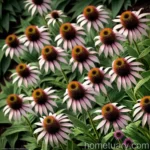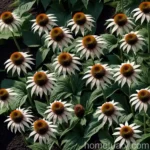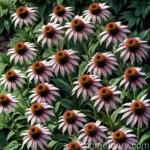Purple Coneflower (Echinacea purpurea ‘Raspberry Truffle’)
As a plant scientist, I am excited to delve into the world of Echinacea purpurea, specifically the delightful variety known as ‘Raspberry Truffle.’ This stunning plant is a member of the daisy family, Asteraceae, and is a perennial herb native to eastern North America.
What is Echinacea purpurea ‘Raspberry Truffle’?
Echinacea purpurea ‘Raspberry Truffle’ is a cultivar of the purple coneflower, known for its vibrant, daisy-like flowers and its resilience in various climatic conditions. This variety is celebrated for its unique, deep reddish-purple blooms that add a burst of color to gardens and landscapes.
Key Takeaways:
- Scientific Name: Echinacea purpurea ‘Raspberry Truffle’
- Family: Asteraceae
- Common Name: Purple Coneflower, Raspberry Truffle Echinacea
- Origin: Eastern North America
In this comprehensive guide, we will explore the cultivation, uses, environmental preferences, and maintenance of the Echinacea purpurea ‘Raspberry Truffle.’ Moreover, we will discuss its ecological significance, popular uses, common diseases, and pests, alongside tips and tricks for successful cultivation.
Culture and Uses
Water
Echinacea purpurea ‘Raspberry Truffle’ prefers well-draining soil, making it essential to moderate its water needs. It is crucial to avoid overwatering this plant, as it can lead to root rot. Generally, the plant should be watered deeply but infrequently, allowing the soil to dry out slightly between watering sessions.
Sunlight
This cultivar thrives best in full sun, where it can receive at least 6 to 8 hours of direct sunlight daily. Adequate sunlight ensures the development of robust, colorful blooms, making it an ideal choice for open, sunny areas in gardens and landscapes.
Soil
Well-drained, loamy soil with a slightly acidic to neutral pH is optimal for the ‘Raspberry Truffle’ Echinacea. Amending the planting area with organic matter can enhance soil structure and fertility, facilitating healthy growth and flowering.
Fertilizer
Echinacea purpurea ‘Raspberry Truffle’ generally thrives in moderately fertile soil and does not require excessive feeding. However, a light application of balanced fertilizer in early spring can support its growth and flowering.
Pruning
Regular deadheading, where spent flowers are removed, encourages continuous blooming and prevents self-seeding. Additionally, cutting back the plant to ground level in late fall or early spring promotes new growth and maintains a tidy appearance.
Propagation
This cultivar can be propagated through division in the early spring. Dividing the plant every 3 to 4 years helps rejuvenate its growth and flowering capacity, ensuring the continued vitality of the ‘Raspberry Truffle’ Echinacea patch.
Container Popularity
Echinacea purpurea ‘Raspberry Truffle’ is well-suited for container cultivation, adding vibrant hues and a touch of nature to balconies, patios, and other urban spaces. Its compact growth habit and striking blooms make it a popular choice for container gardening enthusiasts.
Common Diseases and Pests
Disease Diagnosis
Echinacea purpurea ‘Raspberry Truffle’ is generally resistant to many common plant diseases. However, issues such as powdery mildew and aster yellows can occasionally affect its foliage and blooms. Regular inspection and appropriate management can help safeguard the plant’s health.
Common Pests
Aphids, Japanese beetles, and leafhoppers are among the pests that might impact the ‘Raspberry Truffle’ Echinacea. Practicing good garden hygiene, such as removing debris and controlling pest populations, can mitigate these potential threats.
Botanist’s Tips
- Adequate Spacing: Provide ample spacing between ‘Raspberry Truffle’ Echinacea plants to allow for good air circulation, reducing the risk of disease.
- Regular Monitoring: Keep a close eye on the plant for signs of distress, disease, or pest infestations to address issues promptly.
- Mulching: Apply a layer of mulch around the base of the plant to help regulate soil moisture and suppress weed growth.
Fun Facts
- Echinacea purpurea is a well-regarded medicinal herb known for its immune-boosting properties, traditionally used by Native American tribes and later adopted in modern herbal medicine.
- The ‘Raspberry Truffle’ cultivar showcases a stunning color combination that sets it apart in gardens and landscapes, attracting pollinators and enthusiasts alike.
To further your understanding of Echinacea purpurea ‘Raspberry Truffle’ and explore its diverse aspects, we have compiled a list of external resources that offer valuable insights and in-depth information.
Links to External Resources
- Purple Coneflower Varieties and Cultivars
- Growing and Caring for Echinacea purpurea
- Echinacea purpurea Benefits and Medicinal Properties
- Purple Coneflower Planting Guide
- Echinacea purpurea: A Versatile Garden Flower
By delving into these resources, you can gain a comprehensive understanding of purple coneflowers, Echinacea purpurea cultivars, and the captivating ‘Raspberry Truffle’ variety.
In essence, Echinacea purpurea ‘Raspberry Truffle’ is an enchanting and resilient plant that enriches gardens, supports pollinators, and captivates enthusiasts with its striking beauty. Its cultural significance, ecological benefits, and diverse uses underscore its appeal in horticulture and herbalism, making it a cherished addition to any landscape.















